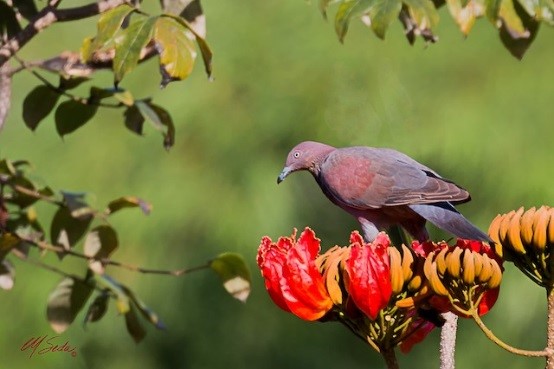Birdfinding.info ⇒ The only pigeon found on all four of the Greater Antilles, but the least common pigeon across most of its range. In the Dominican Republic, often seen at several sites in the southwest: especially Alcoa Road, the Rabo de Gato Trail, in the dry forest near La Placa, and in the thorn scrub along the southern shore of Lago Enriquillo. On Cuba, most readily found in the Sierra de Najasa at Finca La Belen, on the nearby savannas, and at Guanahacabibes National Park. On Jamaica, traditionally found at Portland Ridge in winter, and increasingly reported along the northwest coast near Falmouth and Martha Brae. On Puerto Rico, it is most reliably found in Comerío.
Plain Pigeon
Patagioenas inornata
Endemic to the Greater Antilles: Cuba, the Isle of Youth, Jamaica, Hispaniola, and Puerto Rico. Habitat preferences seem to vary among its populations.
Uncommon but widespread on Hispaniola, where it is largely associated with dry forest and scrub, but occurs in all types of woodland. Mostly rare and local on the other islands.
Cuban populations have been reduced to fragmentary relicts that occupy a few isolated areas, with its main stronghold in Camagüey Province. Other relict populations survive on the Guanahacabibes and Zapata Peninsulas, and possibly in remote mountains of the southeast. Occasionally reported from the south-central and north-central coastal regions.
On Jamaica, exigua was largely unknown for decades, but has been reported more frequently in recent years from several parts of the island: Cockpit Country; the northwestern coast; the arid scrub of Portland Ridge along the south-central coast; and the John Crow Mountains.
The Puerto Rican wetmorei, was believed extinct in the 1930s, then rediscovered in east-central Puerto Rico near Cidra, and the population was then replenished through a captive breeding program. There is a well-known site in Comerío where a few individuals roost in trees behind a baseball field. It is regularly found elsewhere in Comerío and eastward through the municipalities of Cidra, Caguas (especially in Villa Borinquen), San Lorenzo, and Juncos, and occasionally on the southeastern coastal plain at Salinas and Guayama.
Identification
The Plain Pigeon is not really “plain.” The breast and belly are clay-colored, with a reddish blush on the head, neck, and chest. The blush varies from subtle to richly vinaceous or maroon.
Its eyes are strikingly pale and its bill is distinctly bicolored: pale gray with a black tip.
The upperparts are slate-gray with reddish patches on the wings (vinaceous in good light). Also shows a thin whitish bar on the wing, reminiscent of a White-winged Dove, but much fainter.
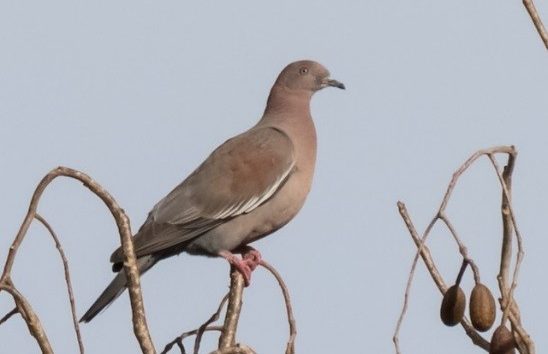
Plain Pigeon, P. i. inornata, showing comparatively plain coloration. (Rancho Belén, Camagüey, Cuba; March 16, 2017.) © R. Dennis Ringer
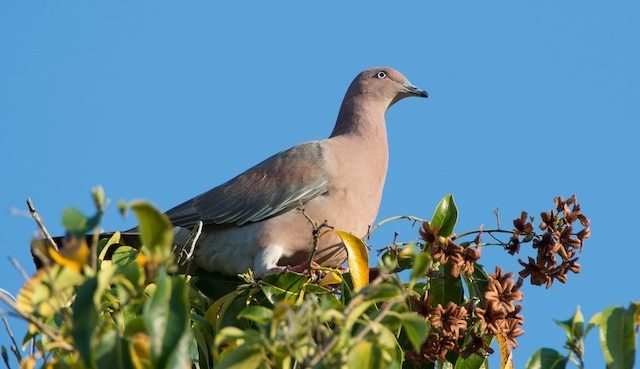
Plain Pigeon, P. i. inornata, showing comparatively plain coloration. (Guanahacabibes National Park, Cuba; February 9, 2013.) © Hank Davis
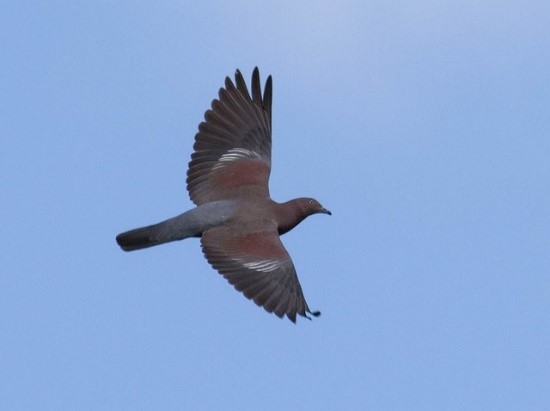
Plain Pigeon, P. i. wetmorei, showing whitish wing stripes. (Comerío, Puerto Rico; March 19, 2016.) © Matthew Sabatine
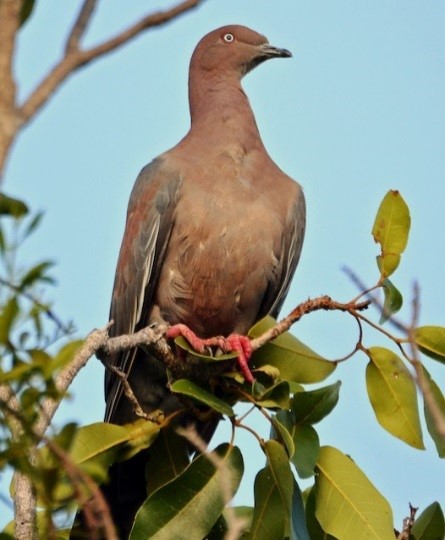
Plain Pigeon, P. i. inornata, showing comparatively rich coloration. (Cabo Corrientes, Guanahacabibes National Park, Cuba; November 8, 2015.) © Michael J. Good

Plain Pigeon, P. i. inornata, showing comparatively rich coloration. (Sierra de Bahoruco, Dominican Republic; December 15, 2012.) © Dax M. Román E.
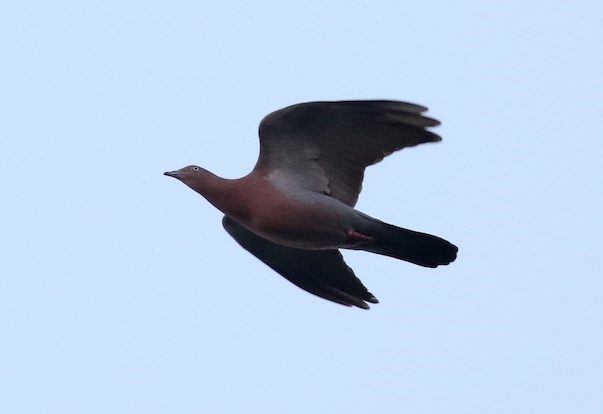
Plain Pigeon, P. i. exigua. (Martha Brae, Jamaica; January 31, 2019.) © Matthew Grube
Cf. Scaly-naped Pigeon. Plain is most likely to be confused with Scaly-naped, which occurs across most of its range. Plain is best distinguished by reddish patch on wings and the absence of Scaly-naped’s distinctive features: i.e., the “scaly” nape, prominent orange eye-combs, and pale-tipped bill. Their calls have a similar cadence, but Plain’s is louder and more emphatic, Scaly-naped’s is more mournful and mellower.
Cf. Ring-tailed Pigeon. On Jamaica, Plain Pigeon can be confused with the Ringtail, as the two have approximately the same general coloration and can appear similar at long range. The Ringtail is plainer than Plain and has a longer, banded tail, whereas Plain has a dark tail, reddish patches and a faint whitish bar on the wings, and a reddish blush on the neck and head.
Notes
Polytypic species consisting of three recognized subspecies: inornata, exigua, and wetmorei.
IUCN Red List Status: Near Threatened.
References
BirdLife International. 2016. Patagioenas inornata. The IUCN Red List of Threatened Species 2016: e.T22690312A93269352. http://dx.doi.org/10.2305/IUCN.UK.2016-3.RLTS.T22690312A93269352.en. (Accessed April 20, 2019.)
Davis, H. 2017. Forest disturbance has negative consequences for the persistence of Jamaica’s threatened and endangered bird species in Cockpit Country. Journal of Caribbean Ornithology 30:57-68.
eBird. 2019. eBird: An online database of bird distribution and abundance. Cornell Lab of Ornithology, Ithaca, N.Y. http://www.ebird.org. (Accessed April 20, 2019.)
Garrido, O.H, and A. Kirkconnell. 2000. Field Guide to the Birds of Cuba. Cornell University Press, Ithaca, N.Y.
Gibbs, D., E. Barnes, and J. Cox. 2001. Pigeons and Doves: A Guide to the Pigeons and Doves of the World. Yale University Press, New Haven, Connecticut.
Haynes-Sutton, A., A. Downer, R. Sutton, and Y.-J. Rey-Millet. 2009. A Photographic Guide to the Birds of Jamaica. Princeton University Press, Princeton, N.J.
Latta, S., C. Rimmer, A. Keith, J. Wiley, H. Raffaele, K. McFarland, and E. Fernandez. 2006. Birds of the Dominican Republic and Haiti. Princeton University Press, Princeton, N.J.
Raffaele, H. 1989. A Guide to the Birds of Puerto Rico and the Virgin Islands. Princeton University Press, Princeton, N.J.
